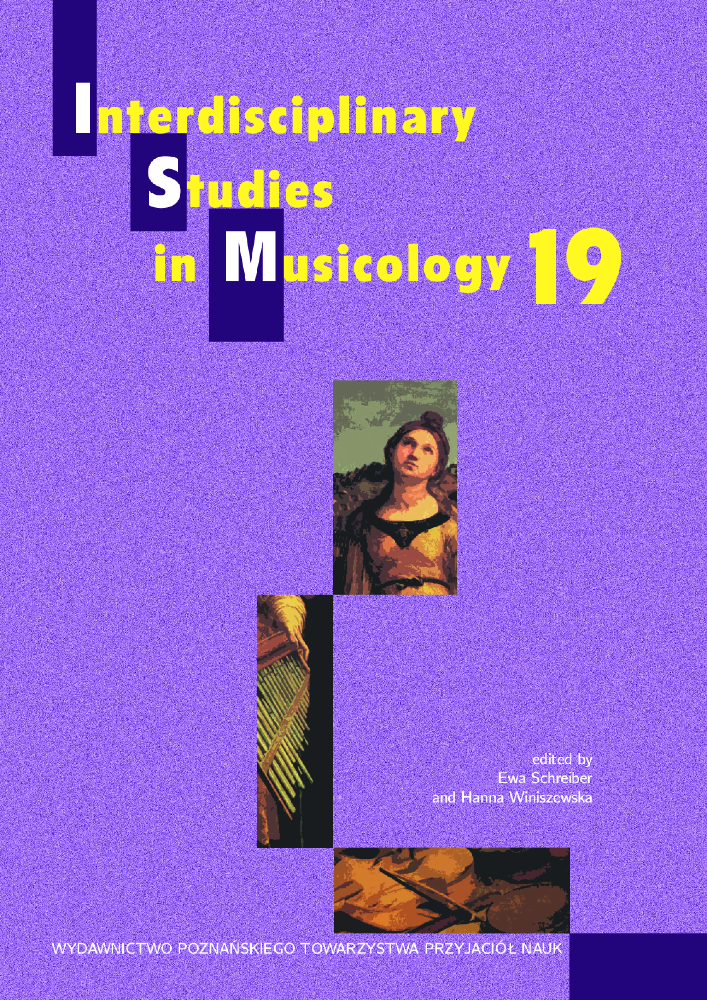Abstrakt
Cognitive psychology, with its focus on mind and its processes, is one of the approaches to study film music. Although music alone is said to be already meaningful, it gains and transfers specific meanings in the film context. This article aims to contribute to understanding of what film music means and how these meanings are processed in the cross-modal perception of a film. A review of the selected empirical research on film music with regard to meaning is followed by a short overview of the Annabel J. Cohen’s Congruence-Association Model (CAM) of media cognition. The model provides a framework for the experiments’ results and encourages future interdisciplinary studies in this area.
Bibliografia
Bolivar, V. J., Cohen, A. J., & Fentress, J. C. (1994). Semantic and formal congruency in music and motion pictures: Effects on the interpretation of visual action. Psychomusicology: A Journal of Research in Music Cognition, 13(1–2), 28–59.
Boltz, M. G. (2001). Musical Soundtracks as a Schematic Influence on the Cognitive Processing of Filmed Events. Music Perception, 18(4), 427–454.
Boltz, M., Schulkind, M., & Kantra, S. (1991). Effects of background music on the remembering of filmed events. Memory & Cognition, 19(6), 593–606.
Bullerjahn, C., & Güldenring, M. (1994). An empirical investigation of effects of film music using qualitative content analysis. Psychomusicology: A Journal of Research in Music Cognition, 13(1–2), 99–118.
Cohen, A. J. (1990). Understanding Musical Soundtracks. Empirical Studies of the Arts, 8(2), 111–124.
Cohen, A. J. (1993). Associationism and musical soundtrack phenomena. Contemporary Music Review, 9(1–2), 163–178.
Cohen, A. J. (1994). Introduction to the special volume on the psychology of film music. Psychomusicology: A Journal of Research in Music Cognition, 13(1–2), 2–8.
Cohen, A. J. (2000). Film music: perspectives from cognitive psychology. In J. Buhler, C. Flinn, & D. Neumeyer (Eds.). Music and cinema (pp. 360–377). Hanover, NH: University Press of New England.
Cohen, A. J. (2013). Congruence-Associationist Model of Music and Multimedia: Origin and Evolution. In S.-L. Tan, A. J. Cohen, S. D. Lipscomb, & R. A. Kendall (Eds.). The psychology of music in multimedia (17–47). New York: Oxford University Press.
Cohen, A. J. (2015). Congruence-Association Model and Experiments in Film Music: Toward Interdisciplinary Collaboration. Music and the Moving Image, 8(2), 5–24.
Gorbman, C. (1987). Unheard Melodies: Narrative Film Music. Bloomington: Indiana University Press.
Lipscomb, S. D., & Kendall, R. A. (1994). Perceptual judgement of the relationship between musical and visual components in film. Psychomusicology, 13, 60–98.
Marshall, S. K., & Cohen, A. J. (1988). Effects of Musical Soundtracks on Attitudes toward Animated Geometric Figures. Music Perception, 6(1), 95–112.
Osgood, C.E., Suci, G.J. and Tannenbaum, P.H. (1957). The measurement of meaning. Urbana: University of Illinois Press.
Sirius, G., & Clark, E. F. (1994). The perception of audio-visual relationships: A preliminary study. Psychomusicology: A Journal of Research in Music Cognition, 13(1–2), 119–132.
Tan, S.-L. (2016). Music and the Moving Image Keynote Address 2015: ‘The Psychology of Film Music: Framing Intuition’, Music and the Moving Image, 9(2), 23–28.
Tan, S.-L. (2017). From intuition to evidence: The experimental psychology of film music. In M. Mera, R. A. Sadoff, & B. Winters (Eds.). The Routledge Companion to Screen Music and Sound (pp. 517–530). New York: Routledge.
Tan, S.-L., Spackman, M. P., Wakefield, E. M. (2017). The Effects of Diegetic and Nondiegetic Music on Viewers’ Interpretations of a Film Scene. Music Perception, 34(5), 605–623.
Tan, S.-L., Spackman, M. P., & Bezdek, M. A. (2007). Viewers’ Interpretations of Film Characters’ Emotions: Effects of Presenting Film Music Before or After a Character is Shown. Music Perception, 25(2), 135–152.
Timmers R., & Granot, R.Y. (2016). Letter of the Guest Editors of the Special Issue on ‘Music as a Multimodal Experience.’ Psychomusicology: Music, Mind, and Brain, 26(2), 101–102.
Vitouch, O. (2001). When your ear sets the stage: Musical context effects in film perception. Psychology of Music, 29(1), 70–83.

